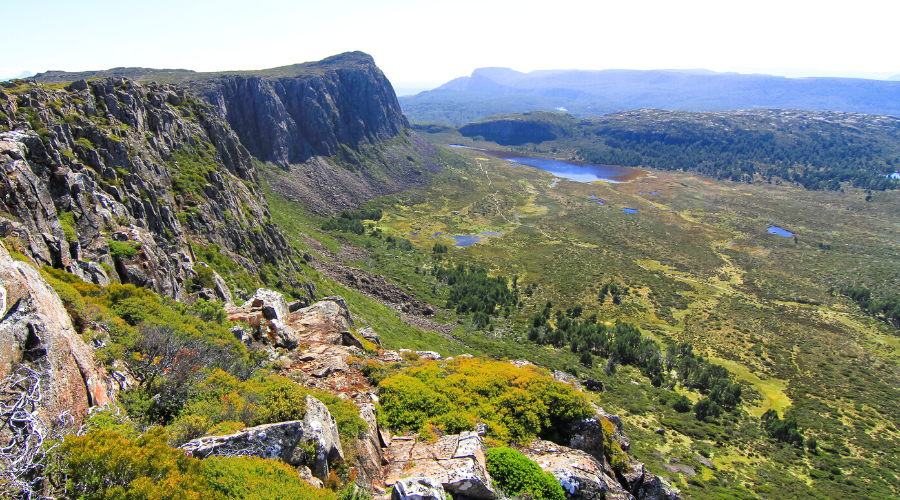Media Releases - 23 June 2021
UNESCO calls halt on tourism developments in Tasmanian Wilderness World Heritage Area

In UNESCO’s new State of Conservation report on World Heritage properties, the World Heritage Committee has expressed multiple concerns (from p70) about the Tasmanian Wilderness World Heritage Area (TWWHA) and has called for an effective moratorium so that a long-called-for Aboriginal cultural assessment can take place “before any further development (eg tourism development) takes place at the property”.
“The Wilderness Society Tasmania backs UNESCO’s effective call for a moratorium on any further ‘development’ of the Tasmania Wilderness World Heritage Area (TWWHA) so that an Aboriginal cultural values survey, with the support and active involvement of the palawa, can be completed first,” said Tom Allen of the Wilderness Society Tasmania.
Commonwealth and State governments have repeatedly promised to honour all 20 recommendations of the 2015 ICOMOS/IUCN Reactive Monitoring Mission to lutruwita/Tasmania but have dragged their feet, partially implemented or failed to implement them, including Recommendation 13 that required a “comprehensive cultural survey” of Aboriginal values for and with the Aboriginal community by 2017.
“In a few years time, if the TWWHA, the world’s highest-rated World Heritage wilderness, continues to be mistreated, privatised and ‘developed’, it could join the Great Barrier Reef on the World Heritage in-danger list. It’s not too late for the Tasmanian Government to change its policies that are causing these problems.
“The World Heritage Committee has made a number of requests and expressed “a number of concerns” about the Gutwein Government’s Tourism Master Plan, as well the ongoing tourism Expressions of Interest process, however, just like local Tasmanian communities, we expect that UNESCO - the ultimate stakeholder - will be ignored too.
“The World Heritage Committee also said that “all proposed tourism developments should be subject to adequate environment impact assessments” and yet the opposite is the case: the Gutwein Government continues to help Wild Drake get its helicopter-accessed bad idea up, despite the government’s own Parks agency finding it would degrade nearly 5,000 hectares of the highest-rated World Heritage wilderness in the world.
“We agree with UNESCO that the logical approach would be to conduct the cultural assessment first and pause any further tourism development but believe that this logic will be ignored because, in reality, the Gutwein Government has a development-at-any-cost approach and its talk about conservation and ‘sensitive development’ is essentially meaningless,” said Mr Allen.
For further comment: Tom Allen, 0434 614 323
The Wilderness Society Tasmania responds to specific points in the ‘State of Conservation’ report:
In response to the item about “most of the recommendations of the 2015 joint ICOMOS/IUCN Reactive Monitoring mission”:
“Tasmania’s and Australia’s governments have repeatedly pledged to honour all 20 recommendations in the Mission’s report but the Tasmanian Government is reneging on recommendation 11. Instead of creating the national parks it said it would, the Tasmanian Government is proposing the lowest level of conservation it can get away with.” (Namely Conservation Areas and Regional Reserves instead of National Parks. Details about this reneging can be found here.]
In response to the item on the fires that “affected the property in 2016 and 2018-19”:
“The report suggests that recovery of impacted vegetation 'may take decades' to recover but there is a real risk that palaeoendemics hit by bushfires, such as Huon pine, deciduous beech, King Billy pine and pencil pine, will never return. Our report Significant Concern: State of Conservation Report on the Tasmanian Wilderness to IUCN, ICOMOS and the World Heritage Centre (April 2019) made clear that: 'If burnt in a severe fire, this type of vegetation will not regenerate.' The plight of the world’s highest-rated World Heritage wilderness is comparable with the Great Barrier Reef because both are threatened by Australia’s failure to take the climate and extinction crises seriously.”
In response to the report’s multiple concerns about the relationship between the TWWHA Management Plan, the tourism master plan and the tourism EOI process:
“On UNESCO’s multiple concerns about how the Tourism Master Plan relates to the statutory Management Plan and the tourism EOI process, the essential point is surely that the tourism EOI process knowingly invites tourism proposals that breach the statutory Management Plan, which is ethically, legally and ecologically contentious, as the Tasmanian Audit Office has previously noted (para 3.6).”
On that request that “details of any project that may affect the property’s Outstanding Universal Value (OUV)” be provided to the World Heritage Committee:
“The Tasmanian Government has not, to our knowledge, informed the World Heritage Committee or the wider public that its own Parks and Wildlife Agency has undertaken a wilderness impact assessment into the proposed Lake Malbena proposal and found that it would degrade nearly 5,000ha of the world’s highest-rated World Heritage wilderness. This would fundamentally weaken the property’s OUV, as would the pipeline of developments the Government wants to see happen, but the World Heritage Committee has been kept in the dark."
On the item about engagement with the Tasmanian Aboriginal people:
“The raft of proposals* identified in the 2016 statutory Management Plan of the TWWHA intended to empower the palawa have not been progressed by the State Government and the Aboriginal community continues to be ignored in its opposition to developments at Lake Malbena, on kunanyi/Mt Wellington, on off-road tracks along the takayna/Tarkine coast over Aboriginal cultural heritage and on its proposed and historic Kooparoona Niara (Great Western Tiers) National Park. It’s pretty cynical to add yet more similar proposals to the Tourism Master Plan, despite failing to progress those in the 2016 Management Plan.” [Details on this proposed national park can be found here.]
*Measures in the 2016 plan included:
a Community Agreement Plan with the Aboriginal community
“governance arrangements… for a non-government Aboriginal organisation in the joint management of Aboriginal cultural values of the TWWHA”
“A comprehensive survey of the TWWHA… to ascertain all Aboriginal values”
Active participation of Aboriginal people in management of the TWWHA on further tourism development